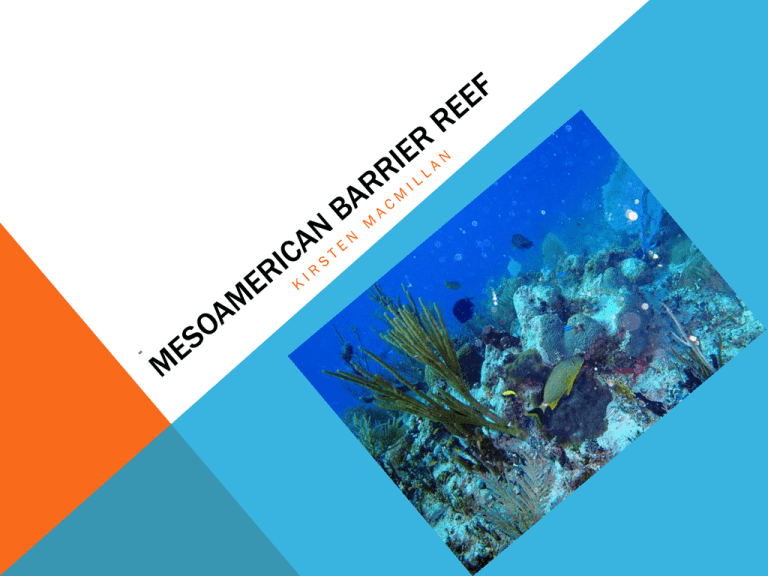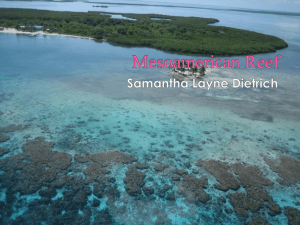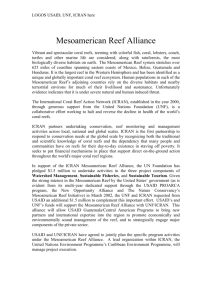Power point presentation on Mesoamerican reef
advertisement

• • • • Along the coast of Mexico, Honduras, Guatemala, and Belize. Largest coral reef in the western hemisphere Amazing display of bio diversity, which is home to 65 species of stony coral, 350 species of mollusk and more than 500 species of fish More than 724 km long Farming and mining practices Introduction of unwanted species Pesticides used in farming cause immense damage to the Mesoamerican Reef. 1. Pesticides reach the reef due to poor infrastructure and slopes and inclines near the water 2. Coral needs very special conditions to thrive, and clean water is crucial 3. Chemicals cause irreversible damage Along with its beautiful appearance, coral has many wasteful uses including Concrete Calcium Souvenirs and jewellery Medical uses Coral souvenirs common in gift shops Coral mining is extremely damaging to the Mesoamerican reef Reefs are built over thousands of years, and cannot grow back quickly Other damage, like sand erosion and sedimentation occurs The loss of coral has huge economic factors, and has been determined to lose between $137,000 to $1.2 million dollars over 25 years per kilometer squared. Habitats for fish and other creatures are destroyed The after math of the BP oil spill had a huge affect on ecosystem in the surrounding area 145 million barrels of oil has leaked since the spill, more than 2.5 million per day More than 8.300 species have been affected by the oil spill Toxic chemicals were used to “disperse” the spill, resulting in even more damage Coral reefs rely on clean water, and the oil began to contaminate these, destroying portions When organisms are introduced to an area, it can cause devastation. This has occurred in the Mesoamerican reef, with things like the lion fish and crown of thorns. Introduced in the 1990s after an aquarium was destroyed during a hurricane Extremely evasive as it has no natural predators Efforts to reduce population were mainly ineffective The lionfish breeds extremely quickly, and can release Studies have shown lionfish reduce the amount of coral fish by an estimated 80% The crown of thorns is the second largest sea star in the world Outbreaks of crown of thorns cause devastating and unchangeable destruction when introduced to coral reefs, as they grow rapidly and stop other coral from being able to grow Sodium bisulphate can be injected to prevent over population Despite many terribly destructive influences to the Mesoamerican coral reef, there is a strong movement trying to keep the reefs alive. Organizations like Healthy Reefs for healthy people work to educate, fundraise, and help protect the coral reefs Annual report cards are produced which give detailed information on how the reefs are declining Coral nurseries have been set up around Belize and Mexico that grow extremely endangered coral and have been very effective Mexico, Guatemala, Belize and Honduras have all made agreements to protect the coral reefs and species Protected areas have been established that have made a huge impact on the health of the reef. In these areas, there are many protective features, including Maintaining endangered species Protecting habitat Banning excessive fishing Lowering the rate of dangerous introduced species, like the lionfish There has been seemingly irreversible damage done to the Mesoamerican reef, however with support we can keep this beautiful, bio diverse and crucial part of our ecosystem alive. Control of Lionfish in the Mesoamerican Reef - GlobalGiving. (n.d.). GlobalGiving: donate to projects in the developing world supporting education, health, women and children, and more. Retrieved June 27, 2011, from http://www.globalgiving.org/projects/control-ofinvasive-lionfish-in-the-mar-reef/ Healthy Reefs Healthy People - Healthy Reefs. (n.d.). Healthy Reefs Healthy People - Healthy Reefs. Retrieved June 27, 2011, from http://healthyreefs.org ICRAN. (n.d.). ICRAN. Retrieved June 27, 2011, from http://www.icran.org/ Mayan riviera: Dive in the Mesoamerican Reef System. (n.d.). Riviera Maya Travel reservations rivieramaya playa del carmen cozumel tulum yucatan mayan location. Retrieved June 27, 2011, from http://www.rivieramaya.info/news/2008/02/dive-inmesoamerican-reef-system.html NOAA Says Invasive Species Prevention and Control Focus Needed on Non-native Lionfish. (n.d.). NOAA Public, Constituent and Intergovernmental Affairs - HOME. Retrieved June 27, 2011, from http://www.publicaffairs.noaa.gov/releases2006/nov06/noaa06r499-4.html National Geographic Mesoamerican Reef: Animals, Photos, Video. (n.d.). National Geographic - Inspiring People to Care About the Planet Since 1888. Retrieved June 27, 2011, from http://www.nationalgeographic.com/wildworld/reef/reef.html PhysOrg Mobile: Efforts to spear invasive lionfish not likely to curb population, researchers say. (n.d.). PhysOrg Mobile: latest science and technology news. Retrieved June 27, 2011, from http://pda.physorg.com/news/2011-06-efforts-spear-invasivelionfish-curb.html Visualizing the BP Oil Spill. (n.d.). IfItWereMyHome.com. Retrieved June 27, 2011, from http://www.ifitweremyhome.com/disasters/bp











